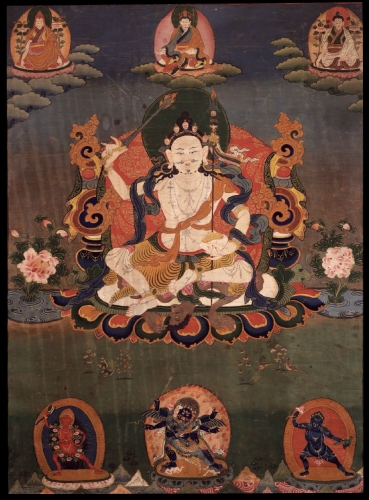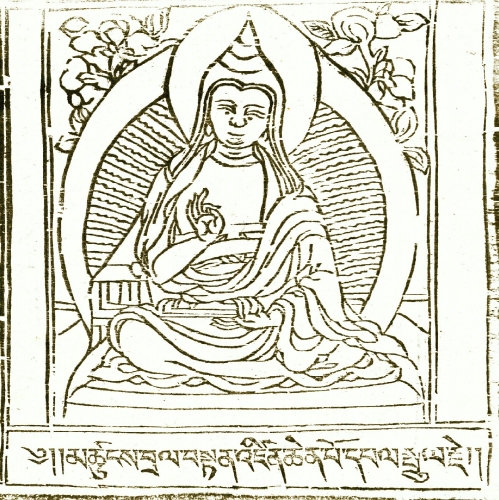Dza Patrul Rinpoche, Orgyen Jigme Chokyi Wangpo (1808-1887) was a brilliant scholar, teacher, and practitioner, primarily known in the West as the author of The Words of My Perfect Teacher. He lived in Kham, eastern Tibet, during a great blossoming of religious activity, when masters of multiple traditions exchanged ideas and shared teachings. His biography on the Treasury of Lives, written by Joshua Schapiro, is an excellent entry into this exciting period.
Many Tibetan Buddhist lamas now teaching, especially those who teach the Longchen Nyingtik [Dzogchen teachings from the Nyingma school], are only a few degrees away from Patrul Rinpoche. Contemporary teachers Dzongsar Khyentse, Sogyal Rinpoche, and Dzigar Kongtrul all trace their lineage back to him, as did other great masters of the twentieth century such as Dilgo Khyentse (1910-1991) and Nyoshul Khenpo (1939-1999).
Realted: Six Lessons from Patrul Rinpoche
Patrul Rinpoche’s best-known work that was translated into English is The Words of My Perfect Teacher, a commentary for the preliminary practices of the Longchen Nyingtik, a Nyingma teaching cycle revealed by Jigme Lingpa (c.1730-1798) in the eighteenth century. Patrul Rinpoche presented The Words of My Perfect Teacher as a transcription of the oral teachings received from one of his own gurus, Jigme Gyelwai Nyugu (1865-1842). This work, both accessible and profound, is full of lively anecdotes and commonsense wisdom, mapping out the entire Buddhist path as it is understood by the Nyingma tradition of Tibetan Buddhism.
Patrul Rinpoche, who was born to the Mukpo clan (the same family to which Trungpa Rinpoche would later belong) spent his life traveling around Kham teaching. Though he was accomplished in advanced tantric practices, he rarely gave public teachings or empowerments, choosing instead to focus much of his time on giving oral commentaries and composing treatises on foundational Mahayana texts. He is particularly known for his commentary on Shantideva’s Bodhicaryavatara, which he taught numerous times to thousands of disciples. Wherever he went, he is said to have encouraged the chanting of “Om mani peme hum,” the mantra of the bodhisattva of compassion, Avalokiteshvara, and several times he successfully discouraged the practice of slaughtering animals for meat offerings to visiting teachers.

One often-repeated story relates how another of Patrul Rinpoche’s gurus, Do Khyentse Yeshe Dorje (1800-1866), introduced him to the nature of mind by grabbing him by the hair, throwing him to the ground, spitting in his face, and insulting him by calling him an “Old Dog.” At first surprised and appalled by the act, Patrul soon realized Do Khyentse, who was famous for his “crazy wisdom” manner of teaching, had been using unconventional methods to break through the remnants of Patrul’s ego. For the rest of his life, he playfully used “Old Dog” as one of his names.
Related: Tibetan Master Patrul Rinpoche Outlines Three Unique Paths to Enlightenment
Though renowned as a brilliant scholar and orator, Patrul was also known for his humility. In Tibetan culture, it was customary for high teachers to sit on thrones, wear brocades, be attended by many people, and be welcomed with great ceremony. In contrast, Patrul Rinpoche would often dress in rags and travel by foot, accompanied by only a few close students. He would often arrive and leave unannounced. He had very few personal belongings, and was said to have treated all people equally. By the time he passed away at the age of eighty, all he left behind was a set of robes, an alms bowl, a yellow shawl, a lower garment, ten days of food, six books, and a few scattered offerings that he had not yet donated. His teachings, however, live on in the commentarial traditions studied in almost every Nyingma curriculum, and his and his students’ books continue to be translated today.
Biography and autobiography in Tibet are important sources for both education and inspiration. Tibetans have kept such meticulous records of their teachers that thousands of names are known and discussed in a wide range of biographical material. All these names, all these lives—it can be a little overwhelming. The authors involved in the Treasury of Lives are currently mining the primary sources to provide English-language biographies of every known religious teacher from Tibet and the Himalaya, all of which are organized for easy searching and browsing.
[This story was first published in 2012]
Thank you for subscribing to Tricycle! As a nonprofit, we depend on readers like you to keep Buddhist teachings and practices widely available.
